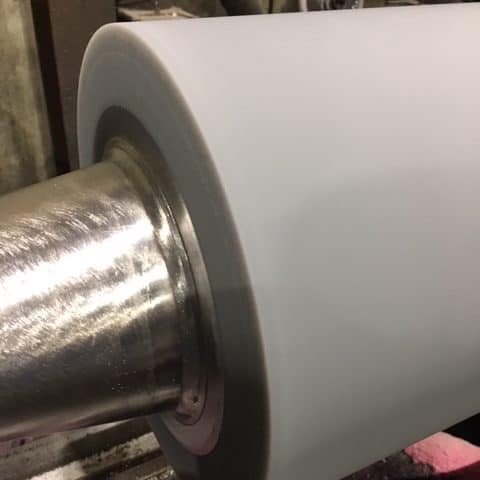Make sure to read part 1 about polyurethanes, here!
Last week we talked about the outstanding properties that are possible with polyurethanes. If you haven’t already read part one, you can find it here. Casting, coating, spraying, with thermoplastic or rubber handling equipment, can prepare urethanes. Since polyurethanes can be a foam, an elastomer, a fiber, a coating, urethanes can be used across a variety of applications.
Applications and End Uses
Let’s talk about rollers. When you make rubber AND polyurethane materials your choice of elastomer is based on what best fits the final application, not what might have been used for many years. Elastomeric materials are not “universal”. The proper choice depends on asking the correct questions, digesting the incoming data, and then proposing the correct material to use.
Polyurethanes have exceptional properties, and with controlled production, procedures are also prepared with a uniform structure that allows use in demanding high-quality applications.
Coating
-
- When chosen for use in metal coating, no pinholes or contaminants are allowed throughout the entire product so that the roller can be reground and a new fresh surface exposed for continued use. The roller is very cost-effective.
- When a certain Ra surface finish is required, proper formulation and the use of high quality grinding equipment and procedures can produce a smooth finish that helps deliver the desired controlled coat weight to the coil or metal sheet.
- When solvent resistance is required, formulating approaches to maximize that property must be employed.
Metal Handling
-
- On coil lines or with metal sheets, the rollers must exhibit toughness, oil resistance, tear resistance, and a good bond.
- In applications where rollers are in constant exposure to high or low pH values and with non-ambient temperatures, then the choice of polyether-based urethanes are required.
- Exposure to oxidative conditions does not cause urethanes to glaze on the surface which would result in a loss of frictional properties. That may have been the property that was desired. Rubber materials do glaze more readily in use.
- Cut propagation is substantially improved when higher hardness rollers are used. Damage of the covering can be made less apt to occur by proper choice of materials.
Many other demanding applications require the correct choice of urethane. The following properties must be considered when selecting a urethane:
- Hardness

- Tear Strength
- Compression Set
- Rebound
- Low Temp Use
- High Temp Use
- Abrasion Quality
- Impingement
- Sliding
- Oil Resistance
The correct selection can get very confusing and requires the attention of a development group that can make the proper choice after all the necessary discussions have been completed. Remember, when you optimize a certain property, you may well have compromised another. A good blend of properties is required.
Producing both rubber and polyurethane materials allows us to be sure we recommend the correct product for your end-use. If urethanes don’t fit due to an application condition that requires a roller to be used in very high-temperature environments that exceed urethane capability (>200F), we can choose the appropriate elastomer that will fit your needs.
To get the urethane you really need, give American Roller a call and we will be more than happy to help!
| Contact Us |
